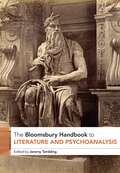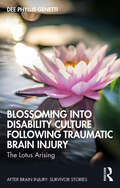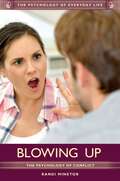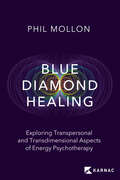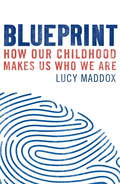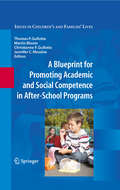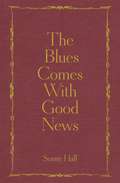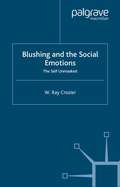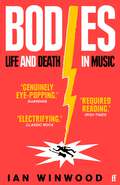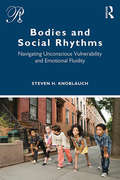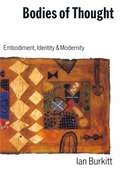- Table View
- List View
The Bloomsbury Handbook to Literature and Psychoanalysis (Bloomsbury Handbooks)
Providing the most comprehensive examination of the two-way traffic between literature and psychoanalysis to date, this handbook looks at how each defines the other as well as addressing the key thinkers in psychoanalytic theory (Freud, Klein, Lacan, and the schools of thought each of these has generated). It examines the debts that these psychoanalytic traditions have to literature, and offers plentiful case-studies of literature's influence from psychoanalysis. Engaging with critical issues such as madness, memory, and colonialism, with reference to texts from authors as diverse as Shakespeare, Goethe, and Virginia Woolf, this collection is admirably broad in its scope and wide-ranging in its geographical coverage. It thinks about the impact of psychoanalysis in a wide variety of literatures as well as in film, and critical and cultural theory.
Blossoming Into Disability Culture Following Traumatic Brain Injury: The Lotus Arising (After Brain Injury: Survivor Stories)
by Dee Phyllis GenettiThis book tells the author’s story of her ten-year journey of recovery and identity transformation from Traumatic Brain Injury (TBI). Dr. Dee is a survivor who regained the ability to articulate what many TBI survivors cannot, and this powerful account, provided in real-time, portrays the many seemingly unrelatable symptoms of brain injury and subsequent post-traumatic stress disorder (PTSD). Dr. Dee portrays how events pushed her beyond her limits and resulted in life-altering learning experiences, revealing a process of first figuring out how to live, then making meaning of her struggle. When half-way through her PhD program, Dr. Dee was crashed into by a car travelling at 65 miles per hour. She suffered a TBI. She lost her ability to read and write. She had a severe speech impediment and significantly impaired memory. Her journey of recovery, described in the book as her trek, spans four significant periods. The road begins with the loss of most of herself. Diagnosis and evolving symptoms show her broken pathway. The author goes through a rocky road of changes in her relationships and reidentification of herself as she finds her life coach, re-learns to read and write, and deals with mental health issues that felt like the end of her recovery. The final trek reveals hope and posttraumatic growth (PTG) and showcases the value of Disability Culture as a source of pride. This story is for fellow TBI survivors, their caretakers, families and friends, and professionals in the neurorehabilitation field. It brings light to the daunting changes after TBI and give hope for all who tread on this challenging path.
Blossoming Into Disability Culture Following Traumatic Brain Injury: The Lotus Arising (After Brain Injury: Survivor Stories)
by Dee Phyllis GenettiThis book tells the author’s story of her ten-year journey of recovery and identity transformation from Traumatic Brain Injury (TBI). Dr. Dee is a survivor who regained the ability to articulate what many TBI survivors cannot, and this powerful account, provided in real-time, portrays the many seemingly unrelatable symptoms of brain injury and subsequent post-traumatic stress disorder (PTSD). Dr. Dee portrays how events pushed her beyond her limits and resulted in life-altering learning experiences, revealing a process of first figuring out how to live, then making meaning of her struggle. When half-way through her PhD program, Dr. Dee was crashed into by a car travelling at 65 miles per hour. She suffered a TBI. She lost her ability to read and write. She had a severe speech impediment and significantly impaired memory. Her journey of recovery, described in the book as her trek, spans four significant periods. The road begins with the loss of most of herself. Diagnosis and evolving symptoms show her broken pathway. The author goes through a rocky road of changes in her relationships and reidentification of herself as she finds her life coach, re-learns to read and write, and deals with mental health issues that felt like the end of her recovery. The final trek reveals hope and posttraumatic growth (PTG) and showcases the value of Disability Culture as a source of pride. This story is for fellow TBI survivors, their caretakers, families and friends, and professionals in the neurorehabilitation field. It brings light to the daunting changes after TBI and give hope for all who tread on this challenging path.
Blowing Up: The Psychology of Conflict (The Psychology of Everyday Life)
by Randi MinetorThis is a powerful resource for anyone who wants to understand the nature of interpersonal conflict—to study it, understand why it's a consistent part of human history, and perhaps avert it in their own lives.Why does conflict surround us in everyday life, from spats between individuals to major conflicts involving large groups? Is conflict inevitable? Why are conflicts and differences of opinion often so hard to resolve? Blowing Up: The Psychology of Conflict focuses on interpersonal conflict and the ways that this level of conflict can move beyond the original relationship to permeate larger constructs—small groups, large groups, whole organizations, and even entire nations. By examining both the positive and negative consequences of conflict—and by documenting its existence as normal and common—readers can appreciate how conflict does not immediately equate to negative feelings and how it also can be useful in creating rules and laws, aiding in negotiation, and bringing people together to work toward a common goal.This clear and accessibly written book in Greenwood's Psychology of Everyday Life series provides students with an understanding of the important role conflict plays in our lives, the many forms conflict may take, and the ways that conflict can actually be constructive and useful as well as destructive to relationships, discussions, and groups. The historical overview of established theories and the study of conflict to date provides readers with invaluable perspective into the subject by identifying and analyzing specific conflicts, including well-publicized conflicts in foreign countries. The book also charts conflict throughout the life cycle to help students identify the reasons for conflicts that occur in their own lives—with parents, friends, siblings, employers, romantic partners, and people in authority.
Blowing Up: The Psychology of Conflict (The Psychology of Everyday Life)
by Randi MinetorThis is a powerful resource for anyone who wants to understand the nature of interpersonal conflict—to study it, understand why it's a consistent part of human history, and perhaps avert it in their own lives.Why does conflict surround us in everyday life, from spats between individuals to major conflicts involving large groups? Is conflict inevitable? Why are conflicts and differences of opinion often so hard to resolve? Blowing Up: The Psychology of Conflict focuses on interpersonal conflict and the ways that this level of conflict can move beyond the original relationship to permeate larger constructs—small groups, large groups, whole organizations, and even entire nations. By examining both the positive and negative consequences of conflict—and by documenting its existence as normal and common—readers can appreciate how conflict does not immediately equate to negative feelings and how it also can be useful in creating rules and laws, aiding in negotiation, and bringing people together to work toward a common goal.This clear and accessibly written book in Greenwood's Psychology of Everyday Life series provides students with an understanding of the important role conflict plays in our lives, the many forms conflict may take, and the ways that conflict can actually be constructive and useful as well as destructive to relationships, discussions, and groups. The historical overview of established theories and the study of conflict to date provides readers with invaluable perspective into the subject by identifying and analyzing specific conflicts, including well-publicized conflicts in foreign countries. The book also charts conflict throughout the life cycle to help students identify the reasons for conflicts that occur in their own lives—with parents, friends, siblings, employers, romantic partners, and people in authority.
Blue: A Memoir – Keeping the Peace and Falling to Pieces
by John SutherlandA Sunday Times top-five bestseller'This is a remarkable book . . . profound and deeply moving . . . It has as much to tell us about mental illness as it does about policing' Alastair StewartJohn Sutherland joined the Met in 1992, having dreamed of being a police officer since his teens. Rising quickly through the ranks, he experienced all that is extraordinary about a life in blue: saving lives, finding the lost, comforting the broken and helping to take dangerous people off the streets. But for every case with a happy ending, there were others that ended in desperate sadness, and in 2013 John suffered a major breakdown.Blue is his memoir of crime and calamity, of adventure and achievement, of friendship and failure, of serious illness and slow recovery. With searing honesty, it offers an immensely moving and personal insight into what it is to be a police officer in Britain today.
Blue Bottle Mystery: An Asperger Adventure
by Kathy Hoopmann`I read this book in under an hour and then immediately picked it up and read it again, much to my brother's disappointment ('It's my book!') It is a story that succeeds in the challenge parents and siblings have been faced with for years - how to explain what Autism is without drowning people amidst technical terms and psychology. It contains a lot of information whilst still being an intriguing tale of a boy's adventure that would excite any child whether they had autism or not. It was a wonderful to listen to my brothers cries of 'Oh now I understand,' ' I do that,' ' Aspergers - that's what I have.' The story highlights the problems for family and friends of Autistic children and for the children themselves and allows the reader to take up their part in the story. It provides advice and support, a good explanation of Autism and a heart-warming story. We shall have to buy another copy because both my brother and I love it too much to let the other have a read. My only criticism is that it does not make a good bed-time story as my brother would not go to sleep; he wanted to hear more of the story and tell me more about what he had read. Congratulations on a truly wonderful book. Best of luck.' - Clare Truman (age 14) This is a warm, fun-filled fantasy story for children with a difference: the hero is Ben, a boy with Asperger Syndrome. When Ben and his friend Andy find an old bottle in the school yard, they little realize the surprises about to be unleashed in their lives. Bound up with this exciting mystery is the story of how Ben is diagnosed with Asperger Syndrome and how he and his family deal with the problems and joys that come along. Blue Bottle Mystery is a delight to read that is more than just another kid's book. For the first time, the issues and frustrations that a child may have with Asperger Syndrome are explored within a fictional format especially for children. Its portrayal of Ben as the central character offers other children with autistic spectrum disorders and their peers a positive role model. It is a valuable teaching tool that demystifies children with Asperger Syndrome, justifying their individuality as valid and interesting. In Blue Bottle Mystery Kathy Hoopmann has combined her love of children with her passion for fantasy literature to produce a delightful read for anyone who loves an adventure and wants a unique insight into the mind of an Asperger child.
Blue Bottle Mystery: An Asperger Adventure (PDF)
by Kathy Hoopmann`I read this book in under an hour and then immediately picked it up and read it again, much to my brother's disappointment ('It's my book!') It is a story that succeeds in the challenge parents and siblings have been faced with for years - how to explain what Autism is without drowning people amidst technical terms and psychology. It contains a lot of information whilst still being an intriguing tale of a boy's adventure that would excite any child whether they had autism or not. It was a wonderful to listen to my brothers cries of 'Oh now I understand,' ' I do that,' ' Aspergers - that's what I have.' The story highlights the problems for family and friends of Autistic children and for the children themselves and allows the reader to take up their part in the story. It provides advice and support, a good explanation of Autism and a heart-warming story. We shall have to buy another copy because both my brother and I love it too much to let the other have a read. My only criticism is that it does not make a good bed-time story as my brother would not go to sleep; he wanted to hear more of the story and tell me more about what he had read. Congratulations on a truly wonderful book. Best of luck.' - Clare Truman (age 14) This is a warm, fun-filled fantasy story for children with a difference: the hero is Ben, a boy with Asperger Syndrome. When Ben and his friend Andy find an old bottle in the school yard, they little realize the surprises about to be unleashed in their lives. Bound up with this exciting mystery is the story of how Ben is diagnosed with Asperger Syndrome and how he and his family deal with the problems and joys that come along. Blue Bottle Mystery is a delight to read that is more than just another kid's book. For the first time, the issues and frustrations that a child may have with Asperger Syndrome are explored within a fictional format especially for children. Its portrayal of Ben as the central character offers other children with autistic spectrum disorders and their peers a positive role model. It is a valuable teaching tool that demystifies children with Asperger Syndrome, justifying their individuality as valid and interesting. In Blue Bottle Mystery Kathy Hoopmann has combined her love of children with her passion for fantasy literature to produce a delightful read for anyone who loves an adventure and wants a unique insight into the mind of an Asperger child.
Blue Bottle Mystery - The Graphic Novel: An Asperger Adventure (PDF)
by Kathy HoopmannThis graphic novel re-telling of Kathy Hoopmann's best-selling Blue Bottle Mystery brings the much-loved fantasy story to life for a new generation of readers. The hero is Ben, a boy with Asperger Syndrome (AS). When Ben and his friend Andy find an old bottle in the school yard, little do they know of the surprises about to be unleashed in their lives. Bound up with this exciting mystery is the story of how Ben is diagnosed with AS and how he and his family deal with the problems and joys that come along with it.
Blue Diamond Healing: Exploring Transpersonal and Transdimensional Aspects of Energy Psychotherapy
by Phil Mollon“For decades, Phil Mollon has been one of the most thoughtful and well-grounded voices within the field of energy psychology. So when Dr. Mollon says he is dabbling with powerful healing forces you’ve never heard of, it’s worth a listen. And this book is so much more than just a listen, laying out a new take on the higher dimensions of human experience, integrating it with established psychological principles, and pointing to its implications for your life and practice.” David Feinstein, Ph.D. co-author of The Promise of Energy Psychology Blue Diamond healing, a development from energy psychotherapy, is the result of Phil Mollon’s many years spent exploring the deeper patterns in the human subtle energy system, working beyond the more familiar meridians and chakras. The ‘Blue Diamond’ functions as an energy centre allowing access to higher dimensions that therapists can draw upon to heal the problematic patterns at lower dimensions. Positive effects are achieved more quickly and easily by working from these higher levels, facilitating healing, emotional self-regulation and calming of the nervous system. In Blue Diamond Healing, Mollon provides a hypothetical map of dimensional levels and structures, combining psychology, physics, metaphysics, cosmology, and spirituality, all in one far-reaching framework. The book provides a sophisticated but concise outline of energy psychotherapy and the place of the Blue Diamond within it, including sections on best practice and the ethical aspects of this unique and powerful healing method.
Blueprint: How our childhood makes us who we are
by Lucy Maddox'The best book I've read this year ... It's written in such a beautiful way' - Dr Suzi Gage, Book Shambles podcastFrom birth to adulthood, Blueprint tells you what you need to know about how you became who you areHave you ever wondered how your early life shaped you? From beginning to say simple words like 'mama' and learning how to walk around unaided, to the first day of school and forming new friendships, everyone has been a child. The roots of our adult selves go right back to our first experiences. How we think, act and interact is influenced by our early years, yet most people don't know the key findings from the juiciest child development studies that can give us insight into our adult selves. Weaving together cutting edge research, everyday experience and clinical examples, Dr Lucy Maddox explains how we develop from an unconscious bundle of cells floating about in the dark of the in uterine environment to to a fully grown complex adult, revealing fascinating insights about our personality, relationships and daily lives along the way.
Blueprint: How DNA Makes Us Who We Are
by Robert Plomin'A clear and engaging explanation of one of the hottest fields in science' Steven PinkerOne of the world's top behavioural geneticists argues that we need a radical rethink about what makes us who we areThe blueprint for our individuality lies in the 1% of DNA that differs between people. Our intellectual capacity, our introversion or extraversion, our vulnerability to mental illness, even whether we are a morning person - all of these aspects of our personality are profoundly shaped by our inherited DNA differences. In Blueprint, Robert Plomin, a pioneer in the field of behavioural genetics, draws on a lifetime's worth of research to make the case that DNA is the most important factor shaping who we are. Our families, schools and the environment around us are important, but they are not as influential as our genes. This is why, he argues, teachers and parents should accept children for who they are, rather than trying to mould them in certain directions. Even the environments we choose and the signal events that impact our lives, from divorce to addiction, are influenced by our genetic predispositions. Now, thanks to the DNA revolution, it is becoming possible to predict who we will become, at birth, from our DNA alone. As Plomin shows us, these developments have sweeping implications for how we think about parenting, education, and social mobility.A game-changing book by a leader in the field, Blueprint shows how the DNA present in the single cell with which we all begin our lives can impact our behaviour as adults.
A Blueprint for Promoting Academic and Social Competence in After-School Programs (Issues in Children's and Families' Lives #10)
by Thomas P. Gullotta Martin Bloom Jennifer C. Messina Christianne F. GullottaSchool activities alone are not always sufficient to ensure children’s academic progress or socio-emotional development and well-being. And the time when many children typically have the least adult supervision – immediately after school – is also the time that they are at the highest risk to act as perpetrators or become victims of antisocial behavior. Throughout A Blueprint for Promoting Academic and Social Competence in After-School Programs, which focuses on children in grades 1 through 6, noted experts identify the best practices of effective programs and pinpoint methods for enhancing school-based skills and making them portable to home and neighborhood settings. This volume: (1) Analyzes the concepts central to effective after-school programs. (2) Offers developmental, cognitive, and social ecology perspectives on how children learn. (3) Features more than 100 exercises that develop young people’s capabilities for academic, social, moral, and emotional learning – These exercises are ready to use or can be adapted to students’ unique needs. (4) Emphasizes young people’s development as students and as productive members of society during middle to late childhood and early adolescence. (5) Presents explicit theory and evidence that can be used to explain the value of after-school programs for budget proposals. This important book will find an appreciative, ready audience among the program directors who design after-school curricula, the educators who implement them, the mental health and social work professionals who help staff them, and the current crop of graduate students who will create the next generation of programs.
The Blues Comes With Good News: The perfect gift for the poetry lover in your life
by Sonny HallSoul searching poetry for a new generation.Inspired by Diane di Prima, Rene Ricard, Henry Miller and others 'who tell it like it is', The Blues Comes with Good News is a collection of poems by prolific writer, Sonny Hall. The collection ranges from articulating addiction, self-destruction and identity, to romantic relationships, his journey to recovery and his unapologetic depiction of truth, through life and its happenings. At 18 years old Sonny entered a treatment centre for alcohol and drug addiction, after losing his biological mother - who he remained close to despite being adopted aged 4 - to a heroin overdose. Three months into his treatment, Hall started writing poems as a way of ordering 'all the madness' in his head. He has since written hundreds of poems, which all portray his newfound intimacy with life, figuring it out as he goes on, never failing to write sincerely about the sting of life, through a rare candour, explicit and seedy within the realms of his own indulgence. Illustrations by JACK LAVER
Blushing and the Social Emotions: The Self Unmasked
by W. CrozierThe blush is a ubiquitous, but little understood, phenomenon. It involves an involuntary change in the face that can express feelings, reveal character and cause intense anxiety. Crozier provides a scholarly, yet accessible, synthesis of new research, locating blushing within the context of the 'social emotions' of embarrassment, shame and shyness.
Board Certification in Clinical Neuropsychology: A Guide to Becoming ABPP/ABCN Certified Without Sacrificing Your Sanity (AACN Workshop Series)
by Kira E. Armstrong, PhD, ABPP Dean W. Beebe, PhD, ABPP Robin C. Hilsabeck, PhD, ABPP Michael W. Kirkwood PhD, ABPPPursuit of board certification through the American Board of Professional Psychology (ABPP) has become a standard expectation for clinical neuropsychologists. At the time this book was published, the American Board of Clinical Neuropsychology (ABCN) was the fastest growing specialty board of ABPP with over 1,000 active members. However, the board certification process is challenging and can be intimidating. The objectives of this book are to demystify the process and provide practical advice for achieving board certification through ABPP/ABCN. To start, benefits of board certification are summarized and common myths debunked. Next, individual chapters for each step in the process, as well as a chapter devoted to pursuit of the pediatric subspecialty, provide details about essential elements of the task, the process, the timeline, strategies for success, common pitfalls, and what happens behind the scenes at ABPP/ABCN. Each of these chapters also has tips for trainees and supervisors who want to get a jump on preparing for board certification. Finally, encouragement and guidance for individuals who encounter setbacks at any step along the way are offered.
Board Certification in Clinical Neuropsychology: A Guide to Becoming ABPP/ABCN Certified Without Sacrificing Your Sanity (AACN Workshop Series)
by Kira E. Armstrong, PhD, ABPP Dean W. Beebe, PhD, ABPP Robin C. Hilsabeck, PhD, ABPP Michael W. Kirkwood PhD, ABPPPursuit of board certification through the American Board of Professional Psychology (ABPP) has become a standard expectation for clinical neuropsychologists. At the time this book was published, the American Board of Clinical Neuropsychology (ABCN) was the fastest growing specialty board of ABPP with over 1,000 active members. However, the board certification process is challenging and can be intimidating. The objectives of this book are to demystify the process and provide practical advice for achieving board certification through ABPP/ABCN. To start, benefits of board certification are summarized and common myths debunked. Next, individual chapters for each step in the process, as well as a chapter devoted to pursuit of the pediatric subspecialty, provide details about essential elements of the task, the process, the timeline, strategies for success, common pitfalls, and what happens behind the scenes at ABPP/ABCN. Each of these chapters also has tips for trainees and supervisors who want to get a jump on preparing for board certification. Finally, encouragement and guidance for individuals who encounter setbacks at any step along the way are offered.
The Boarding School Girls: Developmental and Cultural Narratives
by Soosan Latham Roya FerdowsThey were children. Put on a train in a strange land, they waved goodbye to a parent as they headed to an educational institution that, unbeknownst to them, was to become their new home. Separated from their loving families, they strived to meet the expectations of the grownups and, in some cases, to rebel against them. Now, independent women, compassionate mothers, and astute professionals, they look back on their youth in the 1960’s and 1970’s to make sense of why they were sent away, and to give meaning to the sources that have sustained them over the years. Ex-boarders themselves, Latham and Ferdows provide vivid and emotionally embodied narratives of everyday lives of The Boarding School Girls. This unique collection of stories explores key issues of identity and lifespan development to seek understanding of the influence of national, religious and family culture on development within two conflicting sets of cultural values. Combining unique qualitative data with illuminating tales of resilience and accomplishment in what is likely to simultaneously inform and inspire readers with feelings of joy and sadness, love and hate, abandonment and hope, but mainly trust and forgiveness. The stories of eleven ‘little rich’ Persian girls are a nostalgic reminder of their past cross-cultural ordeals, a pragmatic perspective on psychological implications of boarding school education in England, and a celebration of the possibilities of the future. The Boarding School Girls is valuable reading for students in cultural, developmental and educational psychology and the humanities, as well as clinical psychologists and educators looking at the impact of boarding school on adolescent development.
The Boarding School Girls: Developmental and Cultural Narratives
by Soosan Latham Roya FerdowsThey were children. Put on a train in a strange land, they waved goodbye to a parent as they headed to an educational institution that, unbeknownst to them, was to become their new home. Separated from their loving families, they strived to meet the expectations of the grownups and, in some cases, to rebel against them. Now, independent women, compassionate mothers, and astute professionals, they look back on their youth in the 1960’s and 1970’s to make sense of why they were sent away, and to give meaning to the sources that have sustained them over the years. Ex-boarders themselves, Latham and Ferdows provide vivid and emotionally embodied narratives of everyday lives of The Boarding School Girls. This unique collection of stories explores key issues of identity and lifespan development to seek understanding of the influence of national, religious and family culture on development within two conflicting sets of cultural values. Combining unique qualitative data with illuminating tales of resilience and accomplishment in what is likely to simultaneously inform and inspire readers with feelings of joy and sadness, love and hate, abandonment and hope, but mainly trust and forgiveness. The stories of eleven ‘little rich’ Persian girls are a nostalgic reminder of their past cross-cultural ordeals, a pragmatic perspective on psychological implications of boarding school education in England, and a celebration of the possibilities of the future. The Boarding School Girls is valuable reading for students in cultural, developmental and educational psychology and the humanities, as well as clinical psychologists and educators looking at the impact of boarding school on adolescent development.
Boarding School Syndrome: The psychological trauma of the 'privileged' child
by Joy SchaverienBoarding School Syndrome is an analysis of the trauma of the 'privileged' child sent to boarding school at a young age. Innovative and challenging, Joy Schaverien offers a psychological analysis of the long-established British and colonial preparatory and public boarding school tradition. Richly illustrated with pictures and the narratives of adult ex-boarders in psychotherapy, the book demonstrates how some forms of enduring distress in adult life may be traced back to the early losses of home and family. Developed from clinical research and informed by attachment and child development theories ‘Boarding School Syndrome’ is a new term that offers a theoretical framework on which the psychotherapeutic treatment of ex-boarders may build. Divided into four parts, History: In the Name of Privilege; Exile and Healing; Broken Attachments: A Hidden Trauma, and The Boarding School Body, the book includes vivid case studies of ex-boarders in psychotherapy. Their accounts reveal details of the suffering endured: loss, bereavement and captivity are sometimes compounded by physical, sexual and psychological abuse. Here, Joy Schaverien shows how many boarders adopt unconscious coping strategies including dissociative amnesia resulting in a psychological split between the 'home self' and the 'boarding school self'. This pattern may continue into adult life, causing difficulties in intimate relationships, generalized depression and separation anxiety amongst other forms of psychological distress. Boarding School Syndrome demonstrates how boarding school may damage those it is meant to be a reward and discusses the wider implications of this tradition. It will be essential reading for psychoanalysts, Jungian analysts, psychotherapists, art psychotherapists, counsellors and others interested in the psychological, cultural and international legacy of this tradition including ex-boarders and their partners.
Boarding School Syndrome: The psychological trauma of the 'privileged' child
by Joy SchaverienBoarding School Syndrome is an analysis of the trauma of the 'privileged' child sent to boarding school at a young age. Innovative and challenging, Joy Schaverien offers a psychological analysis of the long-established British and colonial preparatory and public boarding school tradition. Richly illustrated with pictures and the narratives of adult ex-boarders in psychotherapy, the book demonstrates how some forms of enduring distress in adult life may be traced back to the early losses of home and family. Developed from clinical research and informed by attachment and child development theories ‘Boarding School Syndrome’ is a new term that offers a theoretical framework on which the psychotherapeutic treatment of ex-boarders may build. Divided into four parts, History: In the Name of Privilege; Exile and Healing; Broken Attachments: A Hidden Trauma, and The Boarding School Body, the book includes vivid case studies of ex-boarders in psychotherapy. Their accounts reveal details of the suffering endured: loss, bereavement and captivity are sometimes compounded by physical, sexual and psychological abuse. Here, Joy Schaverien shows how many boarders adopt unconscious coping strategies including dissociative amnesia resulting in a psychological split between the 'home self' and the 'boarding school self'. This pattern may continue into adult life, causing difficulties in intimate relationships, generalized depression and separation anxiety amongst other forms of psychological distress. Boarding School Syndrome demonstrates how boarding school may damage those it is meant to be a reward and discusses the wider implications of this tradition. It will be essential reading for psychoanalysts, Jungian analysts, psychotherapists, art psychotherapists, counsellors and others interested in the psychological, cultural and international legacy of this tradition including ex-boarders and their partners.
Bodies: Life and Death in Music
by Ian WinwoodMoney, freedom, adoring fans: professional musicians seem to have it all. But beneath the surface lies a frightening truth: for years the music industry has tolerated death, addiction and exploitation in the name of entertainment.In Bodies, Ian Winwood explores the industry's reluctance to confront its many failures in a far-reaching story which features first-hand access to artists such as Foo Fighters, Green Day, Trent Reznor, Biffy Clyro, Kings of Leon, Chris Cornell, Mark Lanegan, Pearl Jam. Much more than a touchline reporter, Winwood also tells the tale of his own mental-health collapse following the shocking death of his father. Written with warmth, humour and bracing honesty, Bodies is a deeply personal story and essential reading for musicians and fans alike.
Bodies and Social Rhythms: Navigating Unconscious Vulnerability and Emotional Fluidity (Psychoanalysis in a New Key Book Series)
by Steven KnoblauchThis exciting new book traces the development of an unfolding challenge for psychoanalytic attention, which augments contemporary theoretical lenses focusing on structures of meaning, with an accompanying registration different than and interacting with structural experience. This accompanying registration of experience is given the term ‘fluidity’ in order to characterize it as too fast moving and unformulated to be symbolized with linguistic categorization. Expanding attention from speech meaning to include embodied registrations of rhythm involving tonality, pauses and accents can catalyze additional and often emotionally more significant communications central to the state of the transactional field in any psychoanalytic moment. This perspective is contextualized within recognition of how cultural practices and beliefs are carried along both structural and fluid registrations of experience and can shape emotional turbulence for both interactants in a clinical encounter. Experiences of gender, culture, class and race emerging as sources of conflict and mis-recognition are engaged and illustrated throughout the text. This book, part of the popular "Psychoanalysis in a New Key" book series, will appeal to teaching and practicing psychoanalysts, but also an increasing volume of therapists attending to embodied experience in their practice and drawn to the practical clinical illustrations.
Bodies and Social Rhythms: Navigating Unconscious Vulnerability and Emotional Fluidity (Psychoanalysis in a New Key Book Series)
by Steven KnoblauchThis exciting new book traces the development of an unfolding challenge for psychoanalytic attention, which augments contemporary theoretical lenses focusing on structures of meaning, with an accompanying registration different than and interacting with structural experience. This accompanying registration of experience is given the term ‘fluidity’ in order to characterize it as too fast moving and unformulated to be symbolized with linguistic categorization. Expanding attention from speech meaning to include embodied registrations of rhythm involving tonality, pauses and accents can catalyze additional and often emotionally more significant communications central to the state of the transactional field in any psychoanalytic moment. This perspective is contextualized within recognition of how cultural practices and beliefs are carried along both structural and fluid registrations of experience and can shape emotional turbulence for both interactants in a clinical encounter. Experiences of gender, culture, class and race emerging as sources of conflict and mis-recognition are engaged and illustrated throughout the text. This book, part of the popular "Psychoanalysis in a New Key" book series, will appeal to teaching and practicing psychoanalysts, but also an increasing volume of therapists attending to embodied experience in their practice and drawn to the practical clinical illustrations.
Bodies of Thought
by Ian BurkittIn this incisive and truly impressive book, Ian Burkitt critically addresses the dualism between mind and body, thought and emotion, rationality and irrationality, and the mental and the material, which haunt the post-Cartesian world. Drawing on the work of contemporary social theorists and feminist writers, he argues that thought and the sense of being a person is inseparable from bodily practices within social relations, even though such active experience may be abstracted and expanded upon through the use of symbols. Overcoming classic dualisms in social thought, Burkitt argues that bodies are not purely the constructs of discourses of power: they are also productive, communicative, and invested with powerful capacities for changing the social and natural worlds. He goes on to consider how such powers can be developed in more ethical forms of relations and activities.
